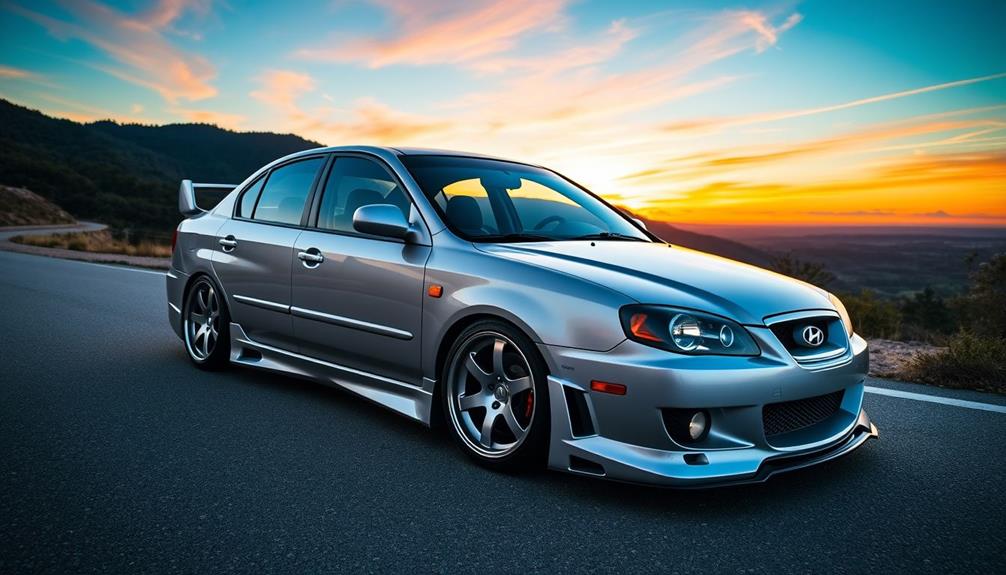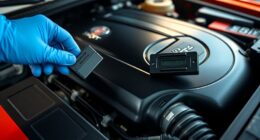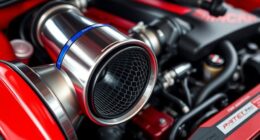Tuning your Hyundai Kona N Line is all about boosting power and style. You can increase performance with ECU tuning, giving you an extra 66 hp and 116 lb-ft of torque. Adding a cold air intake can enhance responsiveness too. For a sportier look, consider body kits and lightweight wheels that improve handling. Don't forget suspension upgrades like coilover kits for personalized ride quality. With advanced driver assistance features and plush interior options, your Kona will stand out on the road. Curious about the best modifications and community tips? There's plenty more to explore on enhancing your ride!
Key Takeaways
- ECU Tuning: The VR Tuned Kit V2 boosts power by 66 hp and 116 lb-ft torque, ensuring a simple plug-and-play installation.
- Cold Air Intake: Installing the Takeda Momentum Cold Air Intake System enhances performance with an additional 14 hp and 21 lb-ft torque.
- Suspension Enhancements: Upgrading with the Megan Racing EZII Coilover Kit improves handling through adjustable damping for a personalized driving experience.
- Aesthetic Upgrades: Body kits, aftermarket wheels, and LED lighting enhance the Kona's sporty appearance while potentially increasing resale value.
- Community Support: Engaging in the Hyundai Kona Forum offers valuable insights and recommendations for performance modifications from fellow enthusiasts.
Key Performance Enhancements
When it comes to enhancing your Hyundai Kona N Line's performance, several key upgrades can make a noticeable difference.
One of the best ways to kick things off is with ECU tuning. Using the VR Tuned ECU Tuning Box Kit V2, you can gain an impressive additional 66 horsepower and 116 lb-ft of torque for just $700. The easy plug-and-play installation means you won't have to worry about warranty issues either.
Next, consider upgrading to a Takeda Momentum Cold Air Intake System. This upgrade can give you up to 14 extra horsepower and 21 lb-ft of torque, thanks to a remarkable 44% improvement in intake outflow.
Pair this with a high-flow exhaust system for enhanced sound and performance—options like the mid-pipe can optimize horsepower without extensive modifications.
Suspension Upgrades for Handling

To truly elevate your Hyundai Kona N Line's handling capabilities, investing in suspension upgrades is essential. You'll want to reflect on options like the Megan Racing EZII Series Coilover Damper Kit, which allows you to adjust damping force for a tailored ride experience at $879.12. Lowering the center of gravity with Eibach Pro-Kit Lowering Springs for $350 enhances steering response and overall dynamics.
Here's a quick comparison of key suspension upgrades:
| Upgrade Type | Benefits |
|---|---|
| Coilover Kit | Adjustable damping for customization |
| Lowering Springs | Improved steering and vehicle dynamics |
| Sway Bars | Reduced body roll for stability |
Adding sway bars will greatly reduce body roll during cornering, making your Kona N Line more responsive in tight turns. Strut braces also increase chassis rigidity, enhancing overall handling during high-speed maneuvers. Finally, don't overlook performance shocks; they provide better damping control, ensuring a smoother ride and improved traction, especially in aggressive driving conditions. These upgrades collectively transform your driving experience, making it more exhilarating and precise.
Aesthetic Customization Options

When it comes to personalizing your Hyundai Kona N Line, there are plenty of aesthetic options to explore.
You can enhance its sporty vibe with body kits and custom wraps, choose lightweight aftermarket wheels for a stylish touch, and upgrade to sleek LED lighting and window tinting for both looks and functionality.
Each of these enhancements not only transforms your vehicle's appearance but also elevates your overall driving experience.
Body Kits and Wraps
A variety of body kits and wraps can transform the Hyundai Kona N Line into a standout vehicle that reflects your personal style. Body kits not only enhance the SUV's aesthetics but also improve aerodynamics, giving it a more aggressive stance while optimizing airflow. This combination can lead to better performance and handling, making your drive even more enjoyable.
Custom wraps are another fantastic option for personalizing your Kona N Line. They allow you to express your unique style while protecting the original paintwork from scratches and UV damage. With countless designs and colors available, you can easily achieve a look that suits you.
Plus, many aftermarket body kits are crafted from lightweight materials, which can reduce overall vehicle weight and contribute to improved performance.
Installing body kits and custom wraps is often straightforward, making it a great DIY project if you're handy. Alternatively, you can opt for professional installation to guarantee a perfect fit.
These aesthetic modifications not only enhance your vehicle's look but can also increase its resale value, appealing to a broader range of buyers interested in customized options.
Aftermarket Wheels Selection
Choosing the right aftermarket wheels can dramatically elevate both the look and performance of your Hyundai Kona N Line. Lightweight 18-inch wheels are an excellent choice, striking a balance between aesthetics and driving dynamics. These wheels not only offer a sportier appearance but also improve handling and acceleration, enhancing your overall driving experience.
When selecting aftermarket wheels, consider options with a wider profile or different offsets. These can give your Kona N Line a more aggressive stance while improving grip and cornering stability.
Plus, many aftermarket wheels are designed to work seamlessly with performance tires, further boosting traction and handling characteristics for spirited driving.
Customization is key, too. With various finishes and designs available, you can truly personalize your vehicle's look. Whether you prefer a sleek matte finish or a shiny chrome look, the options are plentiful.
Lighting and Tinting Options
Upgrading the lighting and tinting on your Hyundai Kona N Line can make a considerable difference in both aesthetics and functionality. By opting for lighting upgrades like LED headlights, you not only enhance visibility but also give your SUV a modern, sleek appearance. These upgrades create a striking look that sets your Kona apart from the crowd.
When it comes to window tinting, you can improve passenger privacy while effectively reducing heat inside the cabin. This makes for a more comfortable ride, especially during hot weather. Additionally, aftermarket tint films offer UV protection, safeguarding your interior materials from fading and prolonging their lifespan.
To elevate your interior aesthetic, consider custom lighting options such as ambient lighting kits. These kits allow you to personalize the ambiance, reflecting your unique style preferences.
Furthermore, combining these lighting upgrades with aesthetic modifications like body kits or wraps will greatly enhance the Kona N Line's aerodynamic profile and visual appeal.
Interior Comfort and Technology

The 2024 Hyundai Kona N Line offers a blend of comfort and cutting-edge technology that elevates your driving experience.
Step inside this compact SUV, and you'll immediately notice the spacious cabin adorned with striking red accents. The six-way power-adjustable driver seat guarantees you find the perfect driving position, enhancing your interior comfort on long journeys.
As you settle in, you'll appreciate the premium Bose sound system, delivering high-quality audio for your favorite tunes. The infotainment system is designed with modern technology in mind, featuring over-the-air updates, navigation, and a customizable interface for media and climate control.
This means you can easily tailor your environment to your liking, making every drive enjoyable and convenient. To further improve your experience, dual-zone climate control allows you and your passengers to set individual temperatures, while ambient lighting customization lets you create the perfect atmosphere.
Plus, the available 360-degree camera system aids in parking and provides better visibility of your surroundings. With the Kona N Line, you're not just driving; you're enjoying a sophisticated blend of interior comfort and advanced technology that makes every ride memorable.
Safety and Driver Assistance Features

Hyundai's commitment to safety shines through in the Kona N Line, packed with advanced driver assistance features that enhance your peace of mind on the road.
The Kona N Line is equipped with a side camera for blind spot monitoring, which greatly boosts your awareness of surrounding vehicles. Plus, with illumination caution symbols in the mirrors, you'll receive visual alerts for potential hazards in your blind spots, ensuring you stay alert.
Inside the cabin, beeping alerts notify you of critical safety information, keeping your attention focused on driving.
The Highway Drive Assist system is another standout feature, combining smart cruise control with navigation data. It automatically adjusts your speed based on traffic conditions and road features, making highway driving smoother and safer.
For parking and maneuvering, the Kona N Line offers an extensive 360-degree camera system, providing a full view of your surroundings.
These safety features, coupled with the driver assistance systems, create a well-rounded safety net that helps you navigate the roads confidently.
With the Kona N Line, you can focus on enjoying the drive while knowing you're backed by cutting-edge safety technology.
Community Insights and Support

If you're looking to connect with fellow Hyundai Kona N-Line enthusiasts, the Hyundai Kona Forum is a great place to start.
With thousands of posts and members, you can share your tuning experiences and get advice tailored to your needs.
Plus, social media platforms are buzzing with discussions that can help you navigate performance upgrades while keeping warranty considerations in mind.
Forum Engagement Opportunities
Engaging with the vibrant Hyundai Kona Forum opens up a wealth of knowledge and support for tuning enthusiasts.
With over 44.3K posts and 12.4K members, you'll find a robust platform dedicated to discussions about the Hyundai Kona, particularly the N Line. Here, community members actively share their personal experiences and recommendations on aftermarket modifications, allowing you to make informed decisions based on real-world results.
The forum serves as a valuable resource for troubleshooting any issues you might encounter related to tuning and performance upgrades. It fosters a supportive environment where you can ask questions and receive guidance from fellow enthusiasts who've faced similar challenges.
Additionally, forum engagement opportunities extend to discussions about OEM performance parts availability and warranty concerns, ensuring you stay informed about the implications of your tuning choices.
Social Media Connections
The Hyundai Kona tuning community thrives not just on forums but also across social media platforms, where enthusiasts share their modifications, performance upgrades, and personal experiences. Instagram is particularly vibrant, brimming with user-generated content that showcases everything from aesthetic enhancements to serious performance upgrades.
When you immerse yourself in this world, you'll find a wealth of inspiration and advice from fellow Kona owners who are keen to help you elevate your ride. Engaging with these social media connections can lead you to valuable insights, especially regarding aftermarket parts and tuning options.
Many enthusiasts stress the importance of doing your research to avoid warranty issues, particularly in the U.S. market. By following hashtags and joining groups dedicated to the Kona, you can easily discover recommendations on performance upgrades like ECU tuning and cold air intake systems that cater to your specific needs.
Moreover, social media often reveals lesser-known OEM performance parts and tuning options available in international markets, widening your choices for enhancements.
Frequently Asked Questions
What Is the Tech Package on the Kona N Line?
The Tech Package on the Kona N Line offers a 10.25-inch touchscreen, a 360-degree camera, Smart Cruise Control, a premium Bose sound system, dual-zone climate control, and ambient lighting, enhancing your driving experience considerably.
How Much Horsepower and Torque Does the Kona N Line Have?
The Kona N Line packs a punch with 190 horsepower and 195 lb-ft of torque from its 1.6L turbocharged engine. You'll appreciate the performance and responsiveness, especially with its advanced transmission and AWD setup.
What Is the 0 60 on a Hyundai Kona N Line?
You grip the wheel, heart racing, as the Hyundai Kona N Line launches forward. In just 6.4 seconds, you're at 60 mph, feeling the thrill of its power surge beneath you. It's exhilarating!
Does the Kona N Line Have Launch Control?
Yes, the Kona N Line features launch control. You can activate it through the drive mode settings, optimizing your acceleration for spirited driving. Just remember, frequent use might affect your vehicle's drivetrain longevity over time.
Conclusion
To sum up, tuning your Hyundai Kona N Line can greatly boost both its performance and style, making every drive a thrilling experience. For instance, imagine upgrading your suspension for sharper handling while cruising through winding roads, giving you that exhilarating edge. Plus, with custom aesthetic touches, your Kona will turn heads wherever you go. Don't just settle—embrace the potential of your compact SUV and join a community that shares your passion for performance and style! Moreover, tuning your Hyundai Kona N Line can also include adding a high-performance exhaust system, further enhancing your SUV’s appearance and providing a more aggressive, sporty sound. Upgrading to larger, stylish alloy wheels and tires can also give your Kona a more commanding presence on the road, adding to its overall appeal. It’s time to take your Kona to the next level and experience the full potential of your compact SUV.










